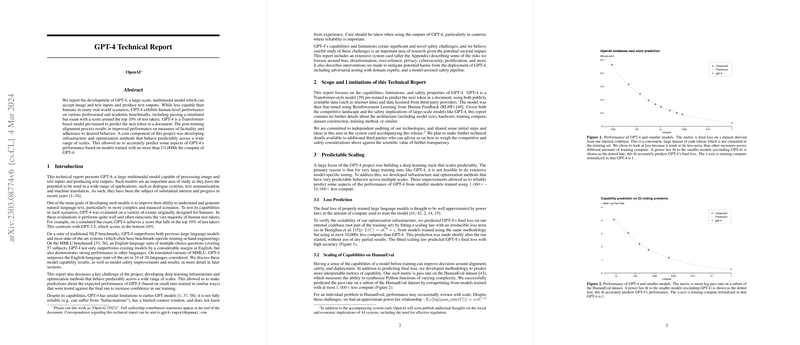GPT-4 Technical Report Overview
The "GPT-4 Technical Report" by OpenAI delineates the intricate architecture, capabilities, limitations, and safety measures associated with GPT-4, a large-scale multimodal model designed to process both image and text inputs, and produce text outputs.
Model Architecture and Training
GPT-4 is distinguished by its multimodal capabilities, allowing it to handle image and text inputs simultaneously, a significant advancement over previous iterations like GPT-3.5. The foundational structure of GPT-4 remains rooted in the Transformer architecture, emphasizing scale predictability and infrastructural robustness across various scales. This predictability was achieved through meticulous tuning and optimization methods that allowed performance predictions based on models trained with significantly less computational resources.
Performance Benchmarks
GPT-4's performance was assessed using a diverse set of benchmarks including professional exams, traditional NLP tasks, and multilingual tests. Notably:
- Professional and Academic Exams: GPT-4 demonstrated impressive capabilities, outscoring GPT-3.5 across multiple exams. For instance, it ranked in the top 10% of a simulated Uniform Bar Examination and achieved the 99th percentile on the Graduate Record Examination (GRE) Verbal section.
- NLP Benchmarks: On the MMLU benchmark, GPT-4 outperformed the previous state-of-the-art, achieving an 86.4% accuracy compared to GPT-3.5's 70.0%. Additionally, in tasks like HellaSwag, and ARC, it consistently surpassed the highest scores of existing LLMs.
- HumanEval: GPT-4 achieved a 67.0% pass rate on the HumanEval dataset, which measures the ability to synthesize Python functions, significantly better than GPT-3.5.
Multilingual Capabilities
GPT-4 exhibited noteworthy performance across languages, outperforming previous models, including Chinchilla and PaLM, in various non-English languages. This includes low-resource languages like Latvian and Welsh, suggesting that GPT-4 has broadened the horizon for multilingual NLP efficacy.
Safety and Alignment
GPT-4 incorporates Reinforcement Learning from Human Feedback (RLHF), enhancing its adherence to user intent and enhancing safety measures. This involved adversarial testing with over 50 domain experts and a sophisticated model-assisted safety pipeline. These measures have substantially improved its ability to refuse inappropriate requests while reducing the occurrence of toxic outputs.
- Mitigation Strategies: GPT-4 was subjected to adversarial testing by experts in fields such as cybersecurity and bio-risk, identifying and mitigating potential safety risks. Measures include rule-based reward models (RBRMs) to guide responses appropriately and reduce undesired behaviors.
- Safety Metrics: The model's tendency to respond to disallowed content was reduced by 82% compared to GPT-3.5, and toxic responses were significantly lower on the RealToxicityPrompts dataset.
Vision Capabilities
GPT-4’s ability to process visual inputs was highlighted with various examples, including interpreting diagrams, providing explanations for memes, and solving exam questions with visual components. Preliminary results indicate that the model retains its robust language processing skills while adeptly handling visual inputs.
Limitations
Despite substantial advancements, GPT-4 retains some limitations:
- Hallucination Issues: It may still generate incorrect information or reasoning errors, necessitating careful validation in high-stakes contexts.
- Knowledge Cutoff: The model's training data mostly ends in September 2021, which limits its knowledge of subsequent events.
- Context Window: Similar to its predecessors, GPT-4 has a limited context window, affecting its ability to handle very long textual inputs.
Future Directions
Future research and development efforts will likely focus on enhancing the model’s safety, reliability, and expanding its understanding to more recent data. Moreover, the report emphasizes the importance of continued collaboration with external researchers to assess and mitigate potential risks as model capabilities expand.
Conclusion
GPT-4 represents a significant step in AI development, showcasing enhanced capabilities in both language and multimodal tasks. Its performance across a broad spectrum of benchmarks underscores its potential for diverse applications, while ongoing efforts to improve its safety and reliability mark a crucial direction for future advancements. The report provides a comprehensive view of GPT-4's architecture, performance, and safety considerations, offering valuable insights for the continued evolution of AI technologies.
